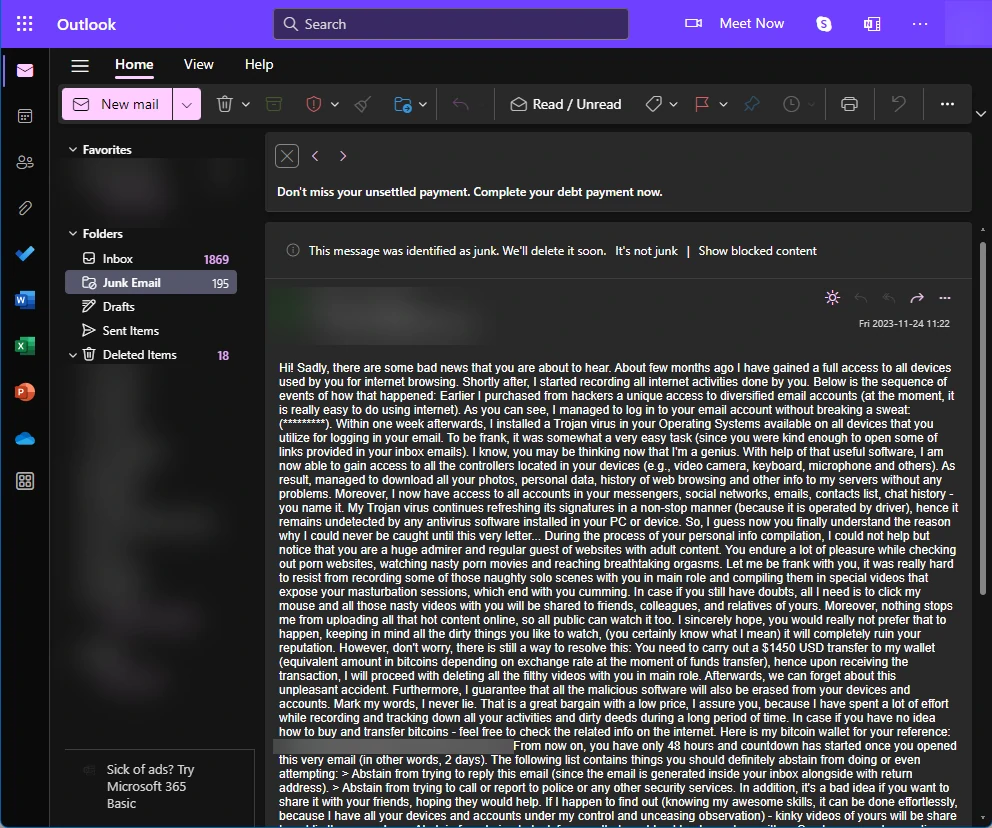The “Some Bad News That You Are About To Hear” sextortion is a scam that spreads via email. It claims to have compromising recordings and demands a $1450 Bitcoin payment to avoid disclosure.
This scam exploits the fear of exposure to manipulate recipients into compliance. While not inherently dangerous, it poses a financial risk and may lead to increased scam attempts. Ignoring and reporting such emails is crucial to thwart scammers and prevent future targeting.
What is “Some Bad News That You Are About To Hear” Scam?
This email, titled “Some Bad News That You Are About To Hear,” is identified as a fraudulent sextortion attempt upon analysis. The sender falsely asserts that they have hacked into the recipient’s computer and acquired compromising recordings. The underlying objective of this scam is to coerce recipients into paying a ransom. It is recommended to disregard and report such emails promptly.

Some Bad News That You Are About To Hear Scam
| Name | Some Bad News That You Are About To Hear Email Scam |
| Threat Type | Phishing, Scam, Social Engineering |
| Distribution methods | This scam is spread wide via spam email campaigns. |
| Damage | Monetary loss |
| Similar Behavitor | “Professional Hacker” Email Scam, “Your Account Was Hacked” Email Scam |
| Fix Tool | See If Your System Has Been Affected by Some Bad News That You Are About To Hear Virus |
How Does “Some Bad News That You Are About To Hear” Scam Work?
The “Some Bad News That You Are About To Hear” sextortion scam asserts that the perpetrators have achieved comprehensive access to all devices employed by recipients for internet activities. The scammers have recorded every facet of the users’ online engagements, including photos, personal information, browsing history, and access to various communication channels such as messengers, social networks, and email accounts, encompassing contact lists and chat histories.
The primary objective of this deceptive email is to deceive recipients into believing that the scammers possess explicit videos of them and threaten to expose this content. The scammers demand a payment of $1450 in Bitcoins to refrain from disclosing the purportedly captured material. Urgency is emphasized, with recipients pressured to pay within a 48-hour. It is advised to treat such communications with skepticism, refrain from making any payments, and promptly report the incident.
Is It Dangerous?
The email does not pose an immediate danger unless the recipient complies with its demands. The primary risk associated with this communication is financial loss. In addition, there’s a potential for an escalation in similar scams targeting the individual. Since scammers have succeeded once, they will likely persist in their attempts.
As mentioned, the recommended action is to disregard the email entirely. Alternatively, marking it as spam and blocking the sender shields the recipient and contributes to refining anti-spam filters. This proactive step may discourage scammers from targeting the individual’s mailbox further.
Remove Some Bad News That You Are About To Hear with Gridinsoft Anti-Malware
We have also been using this software on our systems ever since, and it has always been successful in detecting viruses. It has blocked the most common PUA as shown from our tests with the software, and we assure you that it can remove Some Bad News That You Are About To Hear as well as other malware hiding on your computer.

To use Gridinsoft for remove malicious threats, follow the steps below:
1. Begin by downloading Gridinsoft Anti-Malware, accessible via the blue button below or directly from the official website gridinsoft.com.
2.Once the Gridinsoft setup file (setup-gridinsoft-fix.exe) is downloaded, execute it by clicking on the file.

3.Follow the installation setup wizard's instructions diligently.

4. Access the "Scan Tab" on the application's start screen and launch a comprehensive "Full Scan" to examine your entire computer. This inclusive scan encompasses the memory, startup items, the registry, services, drivers, and all files, ensuring that it detects malware hidden in all possible locations.

Be patient, as the scan duration depends on the number of files and your computer's hardware capabilities. Use this time to relax or attend to other tasks.
5. Upon completion, Anti-Malware will present a detailed report containing all the detected malicious items and threats on your PC.

6. Select all the identified items from the report and confidently click the "Clean Now" button. This action will safely remove the malicious files from your computer, transferring them to the secure quarantine zone of the anti-malware program to prevent any further harmful actions.

8. If prompted, restart your computer to finalize the full system scan procedure. This step is crucial to ensure thorough removal of any remaining threats. After the restart, Gridinsoft Anti-Malware will open and display a message confirming the completion of the scan.
Remember Gridinsoft offers a 6-day free trial. This means you can take advantage of the trial period at no cost to experience the full benefits of the software and prevent any future malware infections on your system. Embrace this opportunity to fortify your computer's security without any financial commitment.
Trojan Killer for “Some Bad News That You Are About To Hear” removal on locked PC
In situations where it becomes impossible to download antivirus applications directly onto the infected computer due to malware blocking access to websites, an alternative solution is to utilize the Trojan Killer application.

There is a really little number of security tools that are able to be set up on the USB drives, and antiviruses that can do so in most cases require to obtain quite an expensive license. For this instance, I can recommend you to use another solution of GridinSoft - Trojan Killer Portable. It has a 14-days cost-free trial mode that offers the entire features of the paid version. This term will definitely be 100% enough to wipe malware out.
Trojan Killer is a valuable tool in your cybersecurity arsenal, helping you to effectively remove malware from infected computers. Now, we will walk you through the process of using Trojan Killer from a USB flash drive to scan and remove malware on an infected PC. Remember, always obtain permission to scan and remove malware from a computer that you do not own.
Step 1: Download & Install Trojan Killer on a Clean Computer:
1. Go to the official GridinSoft website (gridinsoft.com) and download Trojan Killer to a computer that is not infected.

2. Insert a USB flash drive into this computer.
3. Install Trojan Killer to the "removable drive" following the on-screen instructions.

4. Once the installation is complete, launch Trojan Killer.
Step 2: Update Signature Databases:
5. After launching Trojan Killer, ensure that your computer is connected to the Internet.
6. Click "Update" icon to download the latest signature databases, which will ensure the tool can detect the most recent threats.

Step 3: Scan the Infected PC:
7. Safely eject the USB flash drive from the clean computer.
8. Boot the infected computer to the Safe Mode.
9. Insert the USB flash drive.
10. Run tk.exe
11. Once the program is open, click on "Full Scan" to begin the malware scanning process.

Step 4: Remove Found Threats:
12. After the scan is complete, Trojan Killer will display a list of detected threats.

13. Click on "Cure PC!" to remove the identified malware from the infected PC.
14. Follow any additional on-screen prompts to complete the removal process.

Step 5: Restart Your Computer:
15. Once the threats are removed, click on "Restart PC" to reboot your computer.
16. Remove the USB flash drive from the infected computer.
Congratulations on effectively removing Some Bad News That You Are About To Hear and the concealed threats from your computer! You can now have peace of mind, knowing that they won't resurface again. Thanks to Gridinsoft's capabilities and commitment to cybersecurity, your system is now protected.
Frequently Asked Questions (FAQ)
The only risk of this email is financial loss and an increase in similar scams in the future.
The chance of threats being true is minimal. They are often scammers trying to fool naive users. Search for the scam text on Google – you will see info about thousands of same spam messages. There is no way someone can have that much compromising materials.
Ignore, or even delete in from the inbox. Never reply scam messages, regardless of their contents. By replying to a message, you confirm that your mailbox is valid. Even if the current scam is unsuccessful, the scammers will know that this address is “live” and try to pull off other schemes.
How to Remove Some Bad News That You Are About To Hear Malware
Name: Some Bad News That You Are About To Hear
Description: The "Some Bad News That You Are About To Hear" sextortion is a scam that spreads via email. It claims to have compromising recordings and demands a $1450 Bitcoin payment to avoid disclosure. This scam exploits the fear of exposure to manipulate recipients into compliance. While not inherently dangerous, it poses a financial risk and may lead to increased scam attempts. Ignoring and reporting such emails is crucial to thwart scammers and prevent future targeting.
Operating System: Windows
Application Category: Malware


